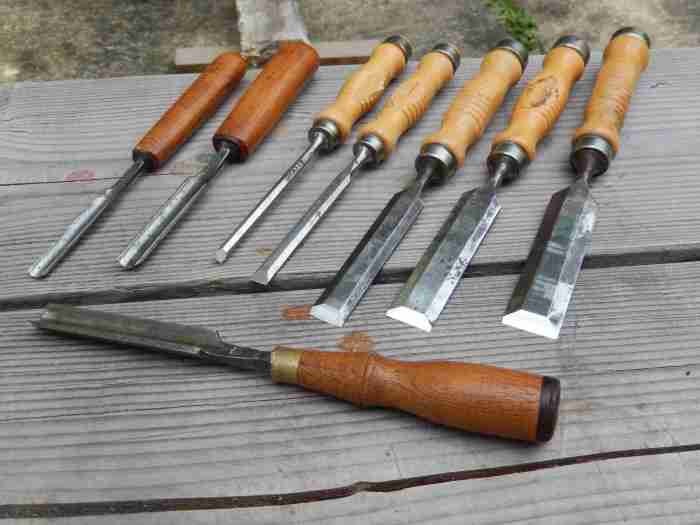A chisel used to cut semi-circular grooves and inside corners is a specialized tool designed for precise and intricate woodworking tasks. Its unique shape and cutting edge allow it to create smooth, curved grooves and clean inside corners, making it an essential tool for a variety of projects.
This chisel’s versatility extends to both woodworking and carving applications. It is commonly used for creating decorative moldings, shaping furniture components, and carving intricate designs. Its ability to cut both inside and outside curves makes it an indispensable tool for artisans and craftspeople alike.
Definition of a Chisel Used to Cut Semi-Circular Grooves and Inside Corners

A chisel specifically designed for cutting semi-circular grooves and inside corners is known as a gouge. Gouges are characterized by their curved cutting edge, which allows for precise and intricate carving. Unlike flat chisels, which are used for creating straight cuts and flat surfaces, gouges excel in shaping concave surfaces and hollowing out areas.
Design and Construction
Gouges typically feature a curved blade with a sharpened edge. The curvature of the blade varies depending on the intended use, with tighter curves for smaller and more intricate cuts. The blade is usually made of high-quality steel, hardened and tempered for durability and edge retention.
The handle of a gouge is often made of wood or plastic and is designed to provide a comfortable and secure grip.
Importance of the Cutting Edge and Its Angle
The cutting edge of a gouge is crucial for its performance. The angle of the cutting edge determines the depth and shape of the cuts made. A steeper angle results in deeper cuts, while a shallower angle produces more shallow and controlled cuts.
Contribution of the Chisel’s Handle
The handle of a gouge plays a significant role in its functionality. A well-designed handle provides a firm and comfortable grip, allowing for precise control during carving. The length and shape of the handle can vary depending on the size and intended use of the gouge.
Applications
Gouges are versatile tools used in various woodworking and carving applications. They are commonly employed in:
- Creating semi-circular grooves and channels
- Hollowing out and shaping concave surfaces
- Carving intricate designs and details
- Creating decorative moldings and trims
- Sculpting and shaping wood for artistic purposes
Examples of Projects
Gouges are commonly used in projects such as:
- Creating decorative bowls and spoons
- Carving furniture details and ornaments
- Making musical instruments
- Producing intricate carvings for signs and artwork
Advantages and Limitations
Gouges offer several advantages:
- Precise and intricate cuts
- Versatility in shaping concave surfaces
- Ease of use with proper technique
However, they also have limitations:
- Require skill and practice to master
- Can be more challenging to control than flat chisels
- May require specialized sharpening techniques
Techniques and Procedures

Using a gouge effectively requires proper techniques and procedures:
Holding and Guiding the Chisel, A chisel used to cut semi-circular grooves and inside corners
Hold the gouge firmly with your dominant hand, placing your thumb on the back of the blade for support. Guide the chisel with your non-dominant hand, keeping your fingers clear of the cutting edge.
Sharpening and Maintaining the Chisel’s Edge
A sharp gouge is essential for precise cuts. Regularly sharpen the cutting edge using a sharpening stone or diamond hone. Maintain the correct angle of the cutting edge for optimal performance.
Safety Considerations
Using a gouge safely requires proper precautions:
- Always wear safety glasses to protect your eyes from flying chips.
- Secure the workpiece firmly to prevent it from moving during carving.
- Keep your hands away from the cutting edge while carving.
- Use a sharp gouge to reduce the risk of slipping and accidents.
- Store the gouge properly in a protective case or sheath.
Related Tools and Accessories: A Chisel Used To Cut Semi-circular Grooves And Inside Corners

Various tools and accessories can enhance the functionality and versatility of a gouge:
- Sharpening stones or diamond hones: For maintaining the cutting edge
- Strop: For honing and polishing the cutting edge
- Mallet or hammer: For striking the chisel when necessary
- Clamps: For securing the workpiece
- Carving gloves: For protecting hands from blisters
Historical Development and Cultural Significance
Gouges have a rich history and cultural significance:
Gouges have been used for centuries in various cultures for woodworking and carving. They were initially made of stone or bone but later evolved to metal as metallurgy advanced. Gouges have played a significant role in creating intricate carvings, sculptures, and decorative objects throughout history.
In modern times, gouges remain essential tools for woodworkers, carvers, and artists. They continue to be used in traditional and contemporary woodworking practices, contributing to the creation of beautiful and functional objects.
FAQs
What is the primary purpose of a chisel used to cut semi-circular grooves and inside corners?
Its primary purpose is to create smooth, curved grooves and clean inside corners in woodworking and carving projects.
How does this chisel differ from other types of chisels?
It differs from other chisels by its unique shape and cutting edge, which is designed specifically for cutting curves and inside corners.
What are some common applications for this chisel?
Common applications include creating decorative moldings, shaping furniture components, and carving intricate designs.
What are the advantages of using this chisel for different applications?
Advantages include its versatility for both woodworking and carving tasks, as well as its ability to create precise and intricate cuts.
What are some safety considerations when using this chisel?
Safety considerations include wearing appropriate safety gear, holding and guiding the chisel correctly, and maintaining a sharp cutting edge.